Padmasambhava
Padmasambhava[note 1] (lit. "He who came into being in a lotus"), also known as Guru Rinpoche, was an 8th-century Buddhist master from India. Padmasambhava was invited to Tibet by king Trisong Detsen and founded Tibetan Buddhism together with other invited scholars and masters. Padmasambhava is venerated as the "second Buddha" by the Nyingma school, the oldest buddhist school in Tibet known of as "the ancient ones". He helped construct the first Buddhist monastery in Tibet at Samye, at the behest of Trisong Detsen.[1] Padmasambhava was presented with Yeshe Tsogyal, either the consort or wife of Trisong Detsen, and she became a great master and Buddha in her lifetime after studying with Padmasambhava.[2]
Padmasambhava, Pema Jugne | |
|---|---|
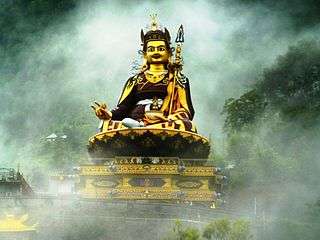 Statue of Padmasambhava 123 ft. (37.5 m) high in mist overlooking Rewalsar Lake, Himachal Pradesh, India. | |
| Ecclesiastical career | |
| Religion | Tibetan Buddhism |
| Part of a series on |
| Tibetan Buddhism |
|---|
 |
|
|
|
Practices and attainment |
|
Institutional roles |
|
History and overview |
A number of legends have grown around Padmasambhava's life and deeds, and he is also widely venerated as a "second Buddha" by adherents of Tibetan Buddhism in Tibet, Nepal, Bhutan, the Himalayan states of India, and elsewhere.[3][4]
In Tibetan Buddhism, Padmasambhava is credited with hiding spiritual lessons, or revelations called terma,[2] which fortunate beings and tertons discover when conditions are ripe for reception. He is also considered an emanation of Amitābha by some practitioners. Padmasambhava is said to appear to tertöns in visionary encounters and is a focus of guru yoga practice, particularly in the Nyingma school. The Nyingma school considers Padmasambhava to be a founder of their tradition.[5]
Historical sources
One of the earliest sources for Padmasambhava as a historical figure is the Testament of Ba (dating to the 9th or 10th centuries), which records the founding of Samye Monastery under the reign of king Trisong Detsen (r. 755–797/804).[6] Other texts from Dunhuang show that Padmasambhava's tantric teachings were being taught in Tibet during the 10th century. New evidence suggests that Padmasambhava already figured in religious myth and ritual, and was probably even seen as the enlightened source of tantric scriptures, as many as two hundred years before Nyangrel Nyima Özer (1136-1204).[7]
Mythos
Sources
Nyangrel Nyima Özer (1136-1204) was the principal architect of the Padmasambhava mythos according to Janet Gyatso.[8] Guru Chöwang (1212–1270) was the next major contributor to the mythos.[8]
In the eleventh and twelfth centuries there were several competing terma traditions surrounding Padmasambhava, Vimalamitra, Songtsän Gampo, and Vairotsana.[9] At the end of the 12th century, there was the "victory of the Padmasambhava cult,"[10] in which a much greater role is assigned to Padmasambhava in the introduction of Buddhism to Tibet.[11]
Early years
Birth
According to tradition, Padmasambhava was incarnated as an eight-year-old child appearing in a lotus blossom floating in Lake Dhanakosha, in the kingdom of Oddiyana.[12] While some scholars locate this kingdom in the Swat Valley area of modern-day Pakistan, a case on literary, archaeological, and iconographical grounds can be made for placing it in the present-day state of Odisha in India.[13] Padmasambhava's special nature was recognized by the childless local king of Oḍḍiyāna, and he was chosen to take over the kingdom; however, he left Oddiyana for northern parts of India.[14][15]
Tantra in India and Nepal
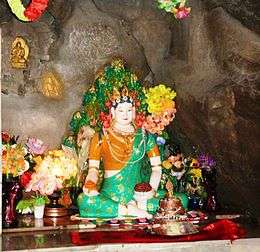
In Rewalsar, known as Tso Pema in Tibetan, he secretly taught tantric teachings to princess Mandarava, the local king's daughter. The king found out and tried to burn both him and his daughter, but it is believed that when the smoke cleared they were still alive and in meditation. Greatly astonished by this miracle, the king offered Padmasambhava both his kingdom and Mandarava.[16]
Padmasambhava left with Mandarava, and took to Maratika Cave[17] in Nepal to practice secret tantric consort rituals. They had a vision of buddha Amitāyus and achieved what is called the "phowa rainbow body,"[note 2] a very rare type of spiritual realization. [note 3] Both Padmasambhava and one of his consorts, Mandarava, are still believed to be alive and active in this rainbow body form by their followers. Mandarava and Padmasambhava's other main consort, Yeshe Tsogyal, who was a great master with many disciples and hid numerous termas in Tibet for later discovery, reached Buddhahood. Many thangkas and paintings show Padmasambhava in between them, with Mandarava on his right and Yeshe Tsogyal on his left.[18]
Tibet
Subjection of local religions
According to Sam van Schaik, from the 12th century on a greater role was assigned to Padmasambhava in the introduction of tantric Buddhism into Tibet:
According to earlier histories, Padmasambhava had given some tantric teachings to Tibetans before being forced to leave due to the suspicions of the Tibetan court. But from the twelfth century an alternative story, itself a terma discovery, gave Padmasambhava a much greater role in the introduction of Buddhism to Tibet, and in particular credited him with travelling all over the country to convert the local spirits to Buddhism.[11]
According to this enlarged story, King Trisong Detsen, the 38th king of the Yarlung dynasty and the first Emperor of Tibet (742–797), invited the Nalanda University abbot Śāntarakṣita (Tibetan Shiwatso) to Tibet.[19] Śāntarakṣita started the building of Samye.[19] Demonical forces hindered the introduction of the Buddhist dharma, and Padmasambhava was invited to Tibet to subdue the demonic forces.[20] The demons were not annihilated, but were obliged to submit to the dharma.[21][note 4] This was in accordance with the tantric principle of not eliminating negative forces but redirecting them to fuel the journey toward spiritual awakening. According to tradition, Padmasambhava received the Emperor's wife, identified with the dakini Yeshe Tsogyal, as a consort.[23]
Translations
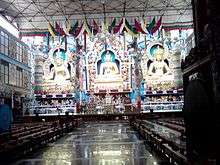
King Trisong Detsen ordered the translation of all Buddhist Dharma Texts into Tibetan. Padmasambhava, Shantarakṣita, 108 translators, and 25 of Padmasambhava's nearest disciples worked for many years in a gigantic translation-project. The translations from this period formed the base for the large scriptural transmission of Dharma teachings into Tibet. Padmasambhava supervised mainly the translation of Tantra; Shantarakshita concentrated on the Sutra-teachings.
Nyingma
Padmasambhava introduced the people of Tibet to the practice of Tantric Buddhism.[21][24]
He is regarded as the founder of the Nyingma tradition. The Nyingma tradition is the oldest of the four major schools of Tibetan Buddhism.[note 5] The Nyingma tradition actually comprises several distinct lineages that all trace their origins to Padmasambhava.
"Nyingma" literally means "ancient," and is often referred to as "Nga'gyur" "[note 6] or the "early translation school" because it is founded on the first translations of Buddhist scriptures from Sanskrit into Tibetan, in the eighth century.[note 7]
The group particularly believes in hidden terma treasures. Traditionally, Nyingmapa practice was advanced orally among a loose network of lay practitioners. Monasteries with celibate monks and nuns, along with the practice of reincarnated spiritual leaders are later adaptations,[25] though Padmasambhava is regarded as the founder of Samye Gompa, the first monastery in the country.[26] In modern times the Nyingma lineage has been centered in Kham in eastern Tibet.
Bhutan
Bhutan has many important pilgrimage places associated with Padmasambhava. The most famous is Paro Taktsang or "Tiger's Nest" monastery which is built on a sheer cliff wall about 900m above the floor of Paro valley. It was built around the Taktsang Senge Samdup (stag tshang seng ge bsam grub) cave where he is said to have meditated in the 8th Century. He flew there from Tibet on the back of Yeshe Tsogyal, whom he transformed into a flying tigress for the purpose of the trip. Later he travelled to Bumthang district to subdue a powerful deity offended by a local king. According to legend, Padmasambhava's body imprint can be found in the wall of a cave at nearby Kurje Lhakhang temple.
Iconography, manifestations and attributes
Iconography
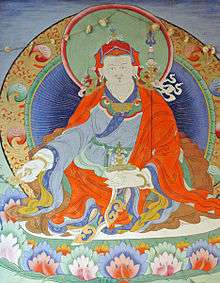
General
Head
- On his head he wears a five-petalled lotus hat,[27][29] which has
- Three points symbolizing the three kayas,
- Five colours symbolizing the five kayas,
- A sun and moon symbolizing skilful means and wisdom,
- A vajra top to symbolize unshakable samadhi,
- A vulture's feather to represent the realization of the highest view.[28]
- His two eyes are wide open in a piercing gaze.[27]
- He has the youthful appearance of an eight-year-old child.[28]
Skin
- His complexion is white with a tinge of red.[28]
Dress
- On his body he wears a white vajra undergarment. On top of this, in layers, a red robe, a dark blue mantrayana tunic, a red monastic shawl decorated with a golden flower pattern, and a maroon cloak of silk brocade.[27]
- On his body he wears a silk cloak, Dharma robes and gown.[29]
- He is wearing the dark blue gown of a mantra practitioner, the red and yellow shawl of a monk, the maroon cloak of a king, and the red robe and secret white garments of a bodhisattva.[28]
Hands
- In his right hand, he holds a five-pronged vajra at his heart.[27][28][29]
- His left hand rests in the gesture of equanimity,[27]
- In his left hand he holds a skull-cup brimming with nectar, containing the vase of longevity that is also filled with the nectar of deathless wisdom[27][28] and ornamented on top by a wish-fulfilling tree.[29]
Khatvanga
The khaṭvāńga is a particular divine attribute of Padmasambhava and intrinsic to his iconographic representation. It is a danda with three severed heads denoting the three kayas (the three bodies of a Buddha, the dharmakaya, sambhogakaya, and nirmanakaya), crowned by a trishula, and dressed with a sash of the Himalayan Rainbow or Five Pure Lights of the Mahabhuta. The iconography is utilized in various Tantric cycles by practitioners as symbols to hidden meanings in transmitted practices.
- Cradled in his left arm he holds the three-pointed khatvanga (trident) symbolizing the Princess consort Mandarava, one of his two main consorts.[27][29] who arouses the wisdom of bliss and emptiness, concealed as the three-pointed khatvanga trident.[28] Other sources say that the khatvanga represents the Lady Yeshe Tsogyal, his primary consort and main disciple.[30]
- Its three points represent the essence, nature and compassionate energy (ngowo, rangshyin and tukjé).[28][29]
- Below these three prongs are three severed heads, dry, fresh and rotten, symbolizing the dharmakaya, sambhogakaya and nirmanakaya.[28][29]
- Nine iron rings adorning the prongs represent the nine yanas.[28][29]
- Five-coloured strips of silk symbolize the five wisdoms[28]
- The khatvanga is also adorned with locks of hair from dead and living mamos and dakinis, as a sign that the Master subjugated them all when he practised austerities in the Eight Great Charnel Grounds.[28][29]
Surrounding
- All around him, within a lattice of five-coloured light, appear the eight vidyadharas of India, the twenty-five disciples of Tibet, the deities of the three roots, and an ocean of oath-bound protectors[29]
There are further iconographies and meanings in more advanced and secret stages.
Eight Manifestations

Padmasambhava is said to have taken eight forms or manifestations (Tib. Guru Tsen Gye) representing different aspects of his being, such as wrath or pacification for example. According to Rigpa Shedra the eight principal forms were assumed by Guru Rinpoche at different points in his life. The Eight Manifestations of Padmasambhava belong to the tradition of the Revealed Treasures (Tib.: ter ma).[31]
- Guru Orgyen Dorje Chang (Wylie: gu ru U-rgyan rDo-rje 'chang, Sanskrit: Guru Uddiyana Vajradhara) The vajra-holder (Skt. Vajradhara), shown dark blue in color in the attire of the Sambhogakaya. Depicted in union with consort.
- Guru Shakya Senge (Wylie: shAkya seng-ge, Skrt: Guru Śākyasimha) of Bodh Gaya, Lion of the Sakyas, who learns the Tantric practices of the eight Vidyadharas. He is shown as a fully ordained Buddhist monk.
- Guru Pema Gyalpo (Wylie: gu ru pad ma rgyal-po, Skrt: Guru Padmarāja) of Uddiyana, the Lotus Prince, king of the Tripitaka (the Three Collections of Scripture). He is shown looking like a young crowned prince or king.
- Guru Pema Jungne (Wylie: pad ma 'byung-gnas, Skrt: Guru Padmakara) Lotus-arisen, the Saviour who teaches the Dharma to the people. He is shown sitting on a lotus, dressed in the three robes of a monk, under which he wears a blue shirt, pants and heavy Tibetan boots, as protection against the cold. He holds the diamond-scepter of compassionate love in his right hand and the yogi's skull-bowl of clear wisdom in his left. He has a special trident called khatvanga of a wandering Yogi, and wears on his head a Nepalese cloth crown, stylistically designed to remind one of the shape of a lotus flower. Thus he is represented as he must have appeared in Tibet, on wikimedia commons
- Guru Loden Chokse (Wylie: gu ru blo ldan mchog sred; Skrt: Guru Mativat Vararuci[32]) of Kashmir, the Intelligent Youth, the one who gathers the knowledge of all worlds. He is shown in princely clothes, beating a hand-drum and holding a skull-bowl.
- Guru Nyima Ozer (Wylie: gu ru nyi-ma 'od-zer, Skrt: Guru Suryabhasa or Sūryaraśmi[32]), the Sunray Yogi, who illuminates the darkness of the mind through the insight of Dzogchen. He is shown as a naked yogi dressed only in a loin-cloth and holding a Khatvanga which points towards the sun.
- Guru Dorje Drolo (Wylie: gu ru rDo-rje gro-lod, Skrt: Guru Vajra ?) the fierce manifestation of Vajrakilaya (wrathful Vajrasattva) known as "Diamond Guts", the comforter of all, imprinting the elements with Wisdom-Treasure.[33]
- Guru Senge Dradog (Wylie: gu ru seng-ge sgra-sgrogs, Skrt: Guru Simhanāda[32]) of Nalanda University, the Lion of Debate, promulgator of the Dharma throughout the six realms of sentient beings. He is shown in a very fierce form, dark blue and imitative of the powerful Bodhisattva Vajrapani, holding a thunderbolt scepter in one hand and a scorpion in the other.
Padmasambhava's various Sanskrit names are preserved in mantras such as those found in the Yang gsang rig 'dzin youngs rdzogs kyi blama guru mtshan brgyad bye brag du sgrub pa ye shes bdud rtsi'i sbrang char zhe bya ba.[32]
Attributes
Pure-land Paradise
His Pureland Paradise is Zangdok Palri (the Copper-Coloured Mountain).[34]
Samantabhadra and Samantabhadri
Padmasambhava said:
My father is the intrinsic awareness, Samantabhadra (Sanskrit; Tib. ཀུན་ཏུ་བཟང་པོ). My mother is the ultimate sphere of reality, Samantabhadri (Sanskrit; Tib. ཀུན་ཏུ་བཟང་མོ). I belong to the caste of non-duality of the sphere of awareness. My name is the Glorious Lotus-Born. I am from the unborn sphere of all phenomena. I act in the way of the Buddhas of the three times.
Teachings and practices ascribed to Padmasambhava
The Vajra Guru mantra

The Vajra Guru (Padmasambhava) mantra Om Ah Hum Vajra Guru Padma Siddhi Hum is favoured and held in esteem by sadhakas. Like most Sanskritic mantras in Tibet, the Tibetan pronunciation demonstrates dialectic variation and is generally Om Ah Hung Benza Guru Pema Siddhi Hung. In the Vajrayana traditions, particularly of the Nyingmapa, it is held to be a powerful mantra engendering communion with the Three Vajras of Padmasambhava's mindstream and by his grace, all enlightened beings.[35] In response to Yeshe Tsogyal's request, the Great Master himself explained the meaning of the mantra although there are larger secret meanings too.[36] The 14th century tertön Karma Lingpa has a famous commentary on the mantra.[37]
The Seven Line Prayer to Padmasambhava
The Seven Line Prayer to Padmasambhava (Guru Rinpoche) is a famous prayer that is recited by many Tibetans daily and is said to contain the most sacred and important teachings of Dzogchen. It is as follows:[38]
Hūṃ! In the north-west of the land of Oḍḍiyāna (hung orgyen yul gyi nubjang tsam)
In the heart of a lotus flower, (pema gesar dongpo la)
Endowed with the most marvellous attainments, (yatsen chok gi ngödrub nyé)
You are renowned as the ‘Lotus-born’, (pema jungné shyé su drak)
Surrounded by many hosts of ḍākinīs (khor du khandro mangpö kor)
Following in your footsteps, (khyé kyi jesu dak drub kyi)
I pray to you: Come, inspire me with your blessing! (jingyi lab chir shek su sol)
guru padma siddhi hūṃ
Jamgon Ju Mipham Gyatso composed a famous commentary to the Seven Line Prayer called White Lotus. It explains the meanings, which are embedded in many levels and intended to catalyze a process of realization. These hidden teachings are described as ripening and deepening, in time, with study and with contemplation.[39] Tulku Thondup says:
Enshrining the most sacred prayer to Guru Padmasambhava, White Lotus elucidates its five layers of meaning as revealed by the eminent scholar Ju Mipham. This commentary now makes this treasure, which has been kept secret among the great masters of Tibet for generations, available as a source of blessings and learning for all.
There is also a shorter commentary, freely available, by Tulku Thondup himself.[40] There are many other teachings and Termas and widely practiced tantric cycles incorporating the text as well as brief ones such as Terma Revelation of Guru Chöwang.[41]
Termas
Padmasambhava also hid a number of religious treasures (termas) in lakes, caves, fields and forests of the Himalayan region to be found and interpreted by future tertöns or spiritual treasure-finders.[42] According to Tibetan tradition, the Bardo Thodol (commonly referred to as the Tibetan Book of the Dead) was among these hidden treasures, subsequently discovered by a Tibetan terton, Karma Lingpa.
Tantric cycles
Tantric cycles related to Padmasambhava are not just practiced by the Nyingma, they even gave rise to a new offshoot of Bon which emerged in the 14th century called the New Bön. Prominent figures of the Sarma (new translation) schools such as the Karmapas and Sakya lineage heads have practiced these cycles and taught them. Some of the greatest tertons revealing teachings related to Padmasambhava have been from the Kagyu or Sakya lineages. The hidden lake temple of the Dalai Lamas behind the Potala called Lukhang is dedicated to Dzogchen teachings and has murals depicting the eight manifestations of Padmasambhava.[43] Padmasambhava established Vajrayana Buddhism and the highest forms of Dzogchen (Mengagde) in Tibet and transformed the entire nation.
Consorts, the King and 25 main students
Many of the students gathered around Padmasambhava became advanced tantric practitioners, and became enlightened. They also found and propagated the Nyingma tradition. The most prominent of these include Padmasambhava's five main female consorts, generally referred to as dakinis, and his twenty five main students along with king Trisong Detsen.
The five main consorts or five wisdom dakinis
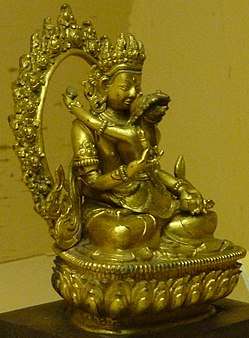
Padmasambhava had five main female tantric companions, beginning in India before his time in Tibet and then in Tibet as well. When seen from an outer, or perhaps even historical or mythological perspective, these five women from across South Asia were known as the Five Consorts. That the women come from very different geographic regions is understood as mandala, a support for Padmasambhava in spreading the dharma throughout the region.
Yet, when understood from a more inner tantric perspective, these same women are understood not as ordinary women but as dakinis; from this point of view, they are known as the "Five Wisdom Dakinis" (Wylie: Ye-shes mKha-'gro lnga). Each of these consorts is believed to be an emanation of the tantric yidam, Vajravārāhī.[44] As one author writes of these relationships:
Yet in reality, he [Padmasambhava] was never separate from the five emanations of Vajravarahi: the Body-emanation, Mandarava; the Speech-emanation, Yeshe Tsogyal; the Mind-emanation, Shakyadema; the Qualities-emanation, Kalasiddhi; and the Activity-emanation, Trashi [sic] Chidren.[45]
In summary, the five consorts/wisdom dakinis were:
- Yeshe Tsogyal of Tibet, who was the emanation of Vajravarahi's Speech (Tibetan: gsung; Sanskrit: vāk);
- Mandarava of Zahor, northeast India, who was the emanation of Vajravarahi's Body (Tibetan: sku; Sanskrit: kāya);
- Belwong Kalasiddhi of northwest India, who was the emanation of Vajravarahi's Quality (Tibetan: yon-tan; Sanskrit: gūna);
- Belmo Sakya Devi of Nepal, who was the emanation of Vajravarahi's Mind (Tibetan: thugs; Sanskrit: citta); and
- Tashi Kyedren (or Chidren) (sometimes called Mangala) of Bhutan, who was the emanation of Vajravarahi's Activity (Tibetan: phrin-las; Sanskrit: karma).[46]
While there are very few sources on the lives of Kalasiddhi, Sakya Devi, and Tashi Kyedren, there are extant biographies of both Yeshe Tsogyal and Mandarava that have been translated into English and other western languages.
The King and 'Twenty-five Main Students' of Padmasambhava
The twenty five main students, (Tibetan: རྗེ་འབངས་ཉེར་ལྔ, Wylie: rje 'bangs nyer lnga ) also called "The King and 25" of Chimphu.[47] [48] In Dudjom Rinpoche's list,[49] and in others lists, these include:
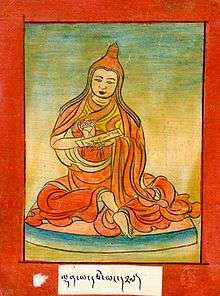
- Denma Tsémang (Tibetan: ལྡན་མ་རྩེ་མང, Wylie: ldan ma rtse mang ) [50]
- Nanam Dorje Dudjom, Dorje Dudjom of Nanam (Tibetan: རྡོ་རྗེ་བདུད་འཇོམ, Wylie: rdo rje bdud 'joms ) [51] (image on Wikimedia commons)
- Drokben Khyechung Lotsawa (Tibetan: ཁྱེའུ་ཆུང་ལོ་ཙཱ་བ, Wylie: khye'u chung lo tsā ba )
- Lasum Gyelwa Changchup, Gyalwa Changchub of Lasum (Tibetan: ལ་སུམ་རྒྱལ་བ་བྱང་ཆུབ, Wylie: la sum rgyal ba byang chub ) [52] (image on Wikimedia commons)
- Gyalwa Choyang (Tibetan: རྒྱལ་བ་མཆོག་དབྱངས, Wylie: rgyal ba mchog dbyangs ) [53]
- Dre Gyelwei Lodro, Gyalwe Lodro of Dré (Tibetan: རྒྱལ་བའི་བློ་གྲོས, Wylie: rgyal ba'i blo gros ) [54]
- Nyak Jnanakumara, Jnanakumara of Nyak (Tibetan: གཉགས་ཛཉའ་ན་ཀུ་མ་ར, Wylie: gnyags dzny' na ku ma ra ) [55]
- Kawa Paltsek (Tibetan: སྐ་བ་དཔལ་བརྩེགས, Wylie: ska ba dpal brtsegs ) [56]
- Karchen-Za, Khandro Yeshe Tsogyal the princess of Karchen (Tibetan: མཁར་ཆེན་བཟའ་མཚོ་རྒྱལ, Wylie: mkhar chen bza' mtsho rgyal )
- Langdro Konchok Jungue, Konchog Jungné of Langdro (Tibetan: ལང་གྲོ་དཀོན་མཆོག་འབྱུང་གནས, Wylie: lang gro dkon mchog 'byung gnas ) [57]
- Sogdian Lhapel, Lhapal the Sokpo (Tibetan: སོག་པོ་ལྷ་དཔལ, Wylie: sog po lha dpal ) [58]
- Namkhai Nyingpo (Tibetan: ནམ་མཁའི་སྙིང་པོ, Wylie: nam mkha'i snying po )
- Nanam Zhang Yeshe De (Tibetan: ཞང་ཡེ་ཤེས་སྡེ, Wylie: zhang ye shes sde )
- Lhalung Pelgi Dorje, Lhalung Pelgyi Dorje (Tibetan: ལྷ་ལུང་དཔལ་གྱི་རྡོ་རྗེ, Wylie: lha lung dpal gyi rdo rje ) [59]
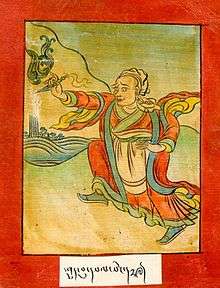
- Shuphu Pelgi Senge, Palgyi Senge (Tibetan: དཔལ་གྱི་སེང་གེ, Wylie: dpal gyi seng ge ) [60]
- Karchen Palgyi Wangchuk (Tibetan: དཔལ་གྱི་དབང་ཕྱུག, Wylie: dpal gyi dbang phyug ) [61]
- Odren Pelgi Wangchuk, Palgyi Wangchuk of Odren (Tibetan: འོ་དྲན་དཔལ་གྱི་དབང་ཕྱུག, Wylie: 'o dran dpal gyi dbang phyug ) [62]
- Palgyi Yeshe (Tibetan: དཔལ་གྱི་ཡེ་ཤེས, Wylie: dpal gyi ye shes )
- Ma Rinchen-chok, Rinchen Chok of Ma (Tibetan: རྨ་རིན་ཆེན་མཆོག, Wylie: rma rin chen mchog ) [63]
- Sangye Yeshe (Tibetan: སངས་རྒྱས་ཡེ་ཤེས, Wylie: sangs rgyas ye shes ) [64]
- Shubu Palgyi Senge (Tibetan: ཤུད་བུ་དཔལ་གྱི་སེང་གེ, Wylie: shud bu dpal gyi seng ge )
- Vairocana, Vairotsana, the great translator (Tibetan: བཻ་རོ་ཙ་ན, Wylie: bai ro tsa na )
- Yeshe Yang (Tibetan: ཡེ་ཤེས་དབྱངས, Wylie: ye shes dbyangs ) [65]
- Gyelmo Yudra Nyingpo, Yudra Nyingpo of Gyalmo (Tibetan: ག་ཡུ་སྒྲ་སྙིང་པོ, Wylie: g.yu sgra snying po )
Also, but not listed in the 25:
- Vimalamitra (Tibetan: དྲུ་མེད་བཤེས་གཉེན, Wylie: dru med bshes gnyen )
- Tingdzin Zangpo (Tibetan: ཏིང་འཛིན་བཟང་པོ, Wylie: ting 'dzin bzang po ) [66] (image on Wikimedia commons)
Also not listed in the 25 while in addition to Yeshe Tsogyal, 15 other women practitioners became accomplished Nyingma masters during the same period:[49][47]
- Tsenamza Sangyetso
- Shekar Dorjetso
- Tsombuza Pematso
- Melongza Rinchensho
- Ruza Tondrupma
- Shubuza Sherampa
- Yamdrokza Choki Dronma
- Oceza Kargyelma
- Dzemza Lhamo
- Barza Lhayang
- Chokroza Changchupman
- Dronma Pamti Chenmo
- Rongmenza Tsultrim-dron
- Khuza Peltsunma
- Trumza Shelmen
Gallery
Biographies/Hagiographies in English
- The Tibetan Book of the Great Liberation. Translated by W. Evans-Wentz. OUP, 2000.
- The Legend of the Great Stupa and the Life Story of the Lotus Born Guru. Orgyen Chokgyur Lingpa. Translated by Keith Dowman. Dharma Publishing, 1973.
- Padmasambhava Comes to Tibet. Yeshe Tsogyal & Tarthang Tulku. Dharma Publishing, 2009.
- The Lotus-Born: The Life Story of Padmasambhava. Yeshe Tsogyal. Translated by Erik Pema Kunsang. Shambhala Publications, 1993
- The Life & Liberation of Padmasambhava (Parts I & II). Yeshe Tsogyal. Translated into French by Gustave-Charles Toussaint. Translated into English by Kenneth Douglas and Gwendolyn Bays. Dharma Publishing, 1978.
- Guru Rinpoché: His Life and Times. Ngawang Zangpo. Snow Lion Publications, 2002.
- The Vajra Garland and the Lotus Garden: Treasure Biographies of Padmakara and Vairochana. Jamgön Kongtrul Lodrö Thaye. Translated by Yeshe Gyamtso. KTD Publications, 2005.
- The Life of Padmasambhava. Taranatha. Translated by Cristiana de Falco. Shang Shung Publications, 2005.
- The Condensed Chronicle by Orgyen Padma. Translated by Tony Duff. Padma Karpo Translation Committee, 2004.
- Biography of Orgyen Guru Pema Jungne. Revealed by Adzom Drukpa. Translated by Padma Samye Ling. Published by Dharma Samudra (restricted).
- The Great Tertön. Chokgyur Lingpa & Phakchok Rinpoche. Akara, 2016.
- Following in Your Footsteps: The Lotus-Born Guru in Nepal. Jamgön Kongtrul & Neten Chokling Rinpoche & Lhasey Lotsawa Translations. Rangjung Yeshe, 2019.
- A Short Biography of Padmasambhava by Jamgon Kongtrul, in Dakini Teachings. Translated by Erik Pema Kunsang. Rangjung Yeshe, 1999.
- A Great Treasure of Blessings, pp. 10–33. Rigpa, 2016.
- Dzogchen and Padmasambhava. Sogyal Rinpoche. Rigpa, 1990.
See also
- Padmasambhava Mahavihara monastery
- Khenchen Palden Sherab
- Boudhanath
- Dzogchen
- Crazy wisdom
- Dudjom Rinpoche
- Thinley Norbu
- Yeshe Tsogyal
- Mandarava
- Trisong Detsen
- Vairotsana
- Śāntarakṣita
- Vimalamitra
- Garab Dorje
- Bardo Thodol
- Terma (religion)
- Terton
- Oddiyana
- Samye
- Epic of King Gesar
Notes
- Sanskrit Padmasambhava; Tibetan: པདྨ་འབྱུང་གནས།, Wylie: pad+ma 'byung gnas (EWTS) ; Mongolian ловон Бадмажунай, lovon Badmajunai, Chinese: 莲花生大士 (pinyin: Liánhuāshēng)
- Wylie 'pho ba chen po, pronounced Phowa Chenpo
- Wylie: 'ja' lus, pronounced Jalü.
- The subjection of concurring deities and demons is a recurrent theme in Buddhist literature. See also Vajrapani and Mahesvara and Steven Heine's "Opening a Mountain".[22]
- The other three being the Kagyu, Sakya and Gelug
- Tibetan: སྔ་འགྱུར།, Wylie: snga 'gyur, ZYPY: Nga'gyur , "school of the ancient translations.
- The Tibetan script and grammar was actually created for this endeavour.
References
Citations
- Kværne, Per (2013). Tuttle, Gray; Schaeffer, Kurtis R. (eds.). The Tibetan history reader. New York: Columbia University Press. p. 168. ISBN 9780231144698.
- Schaik, Sam van. Tibet: A History. Yale University Press 2011, page 34-5, 96-8.
- "Padmasambhava". Encyclopædia Britannica. Retrieved 5 October 2015.
- Buswell, Robert E.; Lopez, Jr., Donald S. (2013). The Princeton dictionary of Buddhism. Princeton: Princeton University Press. p. 608. ISBN 9781400848058. Retrieved 5 October 2015.
- Harvey, Peter (2008). An Introduction to Buddhism Teachings, History and Practices (2 ed.). Cambridge: Cambridge University Press. p. 204. ISBN 9780521676748. Retrieved 6 October 2015.
- van Schaik, Sam; Iwao, Kazushi (2009). "Fragments of the Testament of Ba from Dunhuang". Journal of the American Oriental Society. 128 (3): 477–487. ISSN 0003-0279
- Cantwell, Cathy;Mayer, Rob; REPRESENTATIONS OF PADMASAMBHAVA IN EARLY POST-IMPERIAL TIBET(pg.22). https://ocbs.org/wp-content/uploads/2015/08/Cantwell-Mayer-Early-Representations-of-Padmasambhava-copy.pdf
- Gyatso, Janet (August 2006). "A Partial Genealogy of the Lifestory of Ye shes mtsho rgyal". The Journal of the International Association of Tibetan Studies (2).
- Davidson, Ronald M. Tibetan Renaissance. pg 229. Columbia University Press, 2005.
- Davidson, Ronald M. Tibetan Renaissance. pg 278. Columbia University Press, 2005.
- Schaik, Sam van. Tibet: A History. Yale University Press 2011, page 96.
- Trungpa (2001) 26. For debate on its geographical location, see also the article on Oddiyana.
- Keown, Damien (2003). A Dictionary of Buddhism (1 ed.). Oxford: Oxford University Press. p. 203. ISBN 9780198605607. Retrieved 11 February 2016.
- Morgan (2010) 208.
- Tsogyal (1973) volume I deals with Padmasambhava's life in India.
- Lama Chonam and Sangye Khandro, translators. The Lives and Liberation of Princess Mandarava: The Indian Consort of Padmasambhava. (1998). Wisdom Publications.
- http://www.treasuryoflives.org/institution/Maratika
- "Archived copy". Archived from the original on 2016-05-06. Retrieved 2016-05-07.CS1 maint: archived copy as title (link)
- Snelling 1987, p. 198.
- Snelling 1987, p. 196, 198.
- Snelling 1987.
- Heine 2002.
- 'Guru Rinpoche' and 'Yeshe Tsogyal' in: Forbes, Andrew ; Henley, David (2013). The Illustrated Tibetan Book of the Dead. Chiang Mai: Cognoscenti Books. B00BCRLONM
- Harvey 1995.
- Sherpa, Lhakpa Norbu (2008). Through a Sherpa Window: Illustrated Guide to Sherpa Culture. Kathmandu, Nepal: Vajra Publications. ISBN 978-9937506205. Archived from the original on 2013-05-09.
- Norbu 1987, p. 162.
- Jamyang Khyentse Wangpo, Illuminating the Excellent Path to Omniscience
- Chökyi Drakpa, A Torch for the Path to Omniscience: A Word by Word Commentary on the Text of the Longchen Nyingtik Preliminary Practices.
- Patrul Rinpoche, Brief Guide to the Ngöndro Visualization
- John Huntington and Dina Bangdel. The Circle of Bliss: Buddhist Meditational Art. Columbus Museum of Art, Columbus, Ohio, and Serindia Publications, Chicago. 2004. p. 358.
- Khenchen Palden Sherab Rinpoche The Eight Emanations Of Guru Padmasambhava Archived 2013-09-22 at the Wayback Machine; Rigpawiki Eight Manifestations of Guru Rinpoche; For the eight manifestations as terma, see: Padmasambhava - 8 Forms: Dorje Drolo.
- Boord 1993, p. 115.
- See image + description
- Schmidt and Binder 1993, pp. 252-53.
- Sogyal Rinpoche (1992). The Tibetan Book of Living and Dying, pp. 386-389 Harper, San Francisco. ISBN 0-7126-5437-2.
- Khenpo Namdrol's Padmasambhava Global Project for World Peace
- Benefits and Advantages of the Vajra Guru Mantra
- "Seven Line Prayer". Lotsawa House. Retrieved 15 August 2020.
- White Lotus: An Explanation of the Seven-line Prayer to Guru Padmasambhava by Mipham Rinpoche, Ju and translated by the Padmakara Translation Group Archived 2009-01-25 at the Wayback Machine
- Commentary on the Seven Line Prayer to Guru Rinpoche
- Lotsawa House|Seven Line Prayer, Accomplishing the Lama through the Seven Line Prayer: A Special Teaching from the Lama Sangdü, The Terma Revelation of Guru Chöwang
- Laird (2006) 90.
- Ian A. Baker: The Lukhang: A hidden temple in Tibet.
- Dowman, Keith. (1984). Sky Dancer: The Secret Life and Songs of the Lady Yeshe Tsogyel. p. 265.
- Gyalwa Changchub and Namkhai Nyingpo, Lady of the Lotus-Born: The Life and Enlightenment of Yeshe Tsogyal, Shambhala (1999, pp. 3-4)
- Tibetan Wylie transliteration and Sanskrit transliteration are found in Dowman, Keith. (1984). Sky Dancer: The Secret Life and Songs of the Lady Yeshe Tsogyel. p. 193.
- Khenchen Palden Sherab Rinpoche, Illuminating the Path, pg 179. Padmasambhava Buddhist Center, 2008.
- RigpaShedra
- Dudjom Rinpoche, The Nyingma School of Tibetan Buddhism: Its Fundamentals and History, pg 534-537. Translated by Gyurme Dorje and Matthew Kapstein. Boston: Wisdom Publications. 1991, 2002.
- Mandelbaum, Arthur (August 2007). "Denma Tsemang". The Treasury of Lives: Biographies of Himalayan Religious Masters. Retrieved 2013-08-10.
- Mandelbaum, Arthur (August 2007). "Nanam Dorje Dudjom". The Treasury of Lives: Biographies of Himalayan Religious Masters. Retrieved 2013-08-10.
- Dorje, Gyurme (August 2008). "Lasum Gyelwa Jangchub". The Treasury of Lives: Biographies of Himalayan Religious Masters. Retrieved 2013-08-10.
- Mandelbaum, Arthur (August 2007). "Gyelwa Choyang". The Treasury of Lives: Biographies of Himalayan Religious Masters. Retrieved 2013-08-10.
- Mandelbaum, Arthur (August 2007). "Gyelwai Lodro". The Treasury of Lives: Biographies of Himalayan Religious Masters. Retrieved 2013-08-10.
- Garry, Ron (August 2007). "Nyak Jñānakumara". The Treasury of Lives: Biographies of Himalayan Religious Masters. Retrieved 2013-08-10.
- Mandelbaum, Arthur (August 2007). "Kawa Peltsek". The Treasury of Lives: Biographies of Himalayan Religious Masters. Retrieved 2013-08-10.
- Mandelbaum, Arthur (August 2007). "Langdro Konchok Jungne". The Treasury of Lives: Biographies of Himalayan Religious Masters. Retrieved 2013-08-10.
- Mandelbaum, Arthur (August 2007). "Sokpo Pelgyi Yeshe". The Treasury of Lives: Biographies of Himalayan Religious Masters. Retrieved 2013-08-10.
- Mandelbaum, Arthur (August 2007). "Lhalung Pelgyi Dorje". The Treasury of Lives: Biographies of Himalayan Religious Masters. Retrieved 2013-08-19.
- Mandelbaum, Arthur (August 2007). "Lang Pelgyi Sengge". The Treasury of Lives: Biographies of Himalayan Religious Masters. Retrieved 2013-08-19.
- Mandelbaum, Arthur (August 2007). "Kharchen Pelgyi Wangchuk". The Treasury of Lives: Biographies of Himalayan Religious Masters. Retrieved 2013-08-19.
- Mandelbaum, Arthur (August 2007). "Odren Pelgyi Wangchuk". The Treasury of Lives: Biographies of Himalayan Religious Masters. Retrieved 2013-08-19.
- Mandelbaum, Arthur (August 2007). "Ma Rinchen Chok". The Treasury of Lives: Biographies of Himalayan Religious Masters. Retrieved 2013-08-19.
- Mandelbaum, Arthur (December 2009). "Nubchen Sanggye Yeshe". The Treasury of Lives: Biographies of Himalayan Religious Masters. Retrieved 2013-08-19.
- Mandelbaum, Arthur (August 2007). "Yeshe Yang". The Treasury of Lives: Biographies of Himalayan Religious Masters. Retrieved 2013-08-19.
- Leschly, Jakob (August 2007). "Nyang Tingdzin Zangpo". The Treasury of Lives: Biographies of Himalayan Religious Masters. Retrieved 2013-08-19.
Sources
- Berzin, Alexander (November 10–11, 2000). "History of Dzogchen". Study Buddhism. Retrieved 20 June 2016.CS1 maint: ref=harv (link)
- Bischoff, F.A. (1978). Ligeti, Louis (ed.). "Padmasambhava est-il un personnage historique?". Csoma de Körös Memorial Symposium. Budapest: Akadémiai Kiadó: 27–33. ISBN 963-05-1568-7.
- Boord, Martin (1993). Cult of the Deity Vajrakila. Institute of Buddhist Studies. ISBN 0-9515424-3-5.
- Dudjom Rinpoche The Nyingma School of Tibetan Buddhism: Its Fundamentals and History. Translated by Gyurme Dorje and Matthew Kapstein. Boston: Wisdom Publications. 1991, 2002. ISBN 0-86171-199-8.
- Guenther, Herbert V. (1996), The Teachings of Padmasambhava, Leiden: E.J. Brill, ISBN 90-04-10542-5
- Harvey, Peter (1995), An introduction to Buddhism. Teachings, history and practices, Cambridge University Press
- Heine, Steven (2002), Opening a Mountain. Koans of the Zen Masters, Oxford: Oxford University Press
- Jackson, D. (1979) 'The Life and Liberation of Padmasambhava (Padma bKaí thang)' in: The Journal of Asian Studies 39: 123-25.
- Jestis, Phyllis G. (2004) Holy People of the World Santa Barbara: ABC-CLIO. ISBN 1576073556.
- Kinnard, Jacob N. (2010) The Emergence of Buddhism Minneapolis: Fortress Press. ISBN 0800697480.
- Laird, Thomas. (2006). The Story of Tibet: Conversations with the Dalai Lama. Grove Press, New York. ISBN 978-0-8021-1827-1.
- Morgan, D. (2010) Essential Buddhism: A Comprehensive Guide to Belief and Practice Santa Barbara: ABC-CLIO. ISBN 0313384525.
- Norbu, Thubten Jigme; Turnbull, Colin (1987), Tibet: Its History, Religion and People, Penguin Books, ISBN 0140213821
- Snelling, John (1987), The Buddhist handbook. A Complete Guide to Buddhist Teaching and Practice, London: Century Paperbacks
- Sun, Shuyun (2008), A Year in Tibet: A Voyage of Discovery, London: HarperCollins, ISBN 978-0-00-728879-3
- Taranatha The Life of Padmasambhava. Shang Shung Publications, 2005. Translated from Tibetan by Cristiana de Falco.
- Thondup, Tulku. Hidden Teachings of Tibet: An Explanation of the Terma Tradition of the Nyingma School of Tibetan Buddhism. London: Wisdom Publications, 1986.
- Trungpa, Chögyam (2001). Crazy Wisdom. Boston: Shambhala Publications. ISBN 0-87773-910-2.
- Tsogyal, Yeshe. The Life and Liberation of Padmasambhava. Padma bKa'i Thang. Two Volumes. 1978. Translated into English by Kenneth Douglas and Gwendolyn Bays. ISBN 0-913546-18-6 and ISBN 0-913546-20-8.
- Tsogyal, Yeshe. The Lotus-Born: The Lifestory of Padmasambhava Pema Kunsang, E. (trans.); Binder Schmidt, M. & Hein Schmidt, E. (eds.) 1st edition, Boston: Shambhala Books, 1993. Reprint: Boudhanath: Rangjung Yeshe Publications, 2004. ISBN 962-7341-55-X.
- Wallace, B. Alan (1999), "The Buddhist Tradition of Samatha: Methods for Refining and Examining Consciousness", Journal of Consciousness Studies 6 (2-3): 175-187 .
- Zangpo, Ngawang. Guru Rinpoche: His Life and Times. Snow Lion Publications, 2002.
External links
| Wikiquote has quotations related to: Padmasambhava |
| Wikimedia Commons has media related to: |


